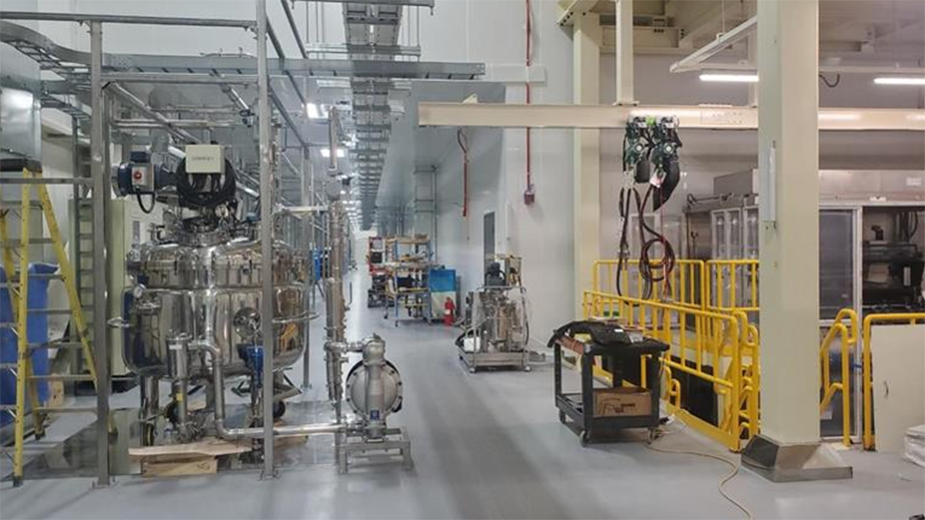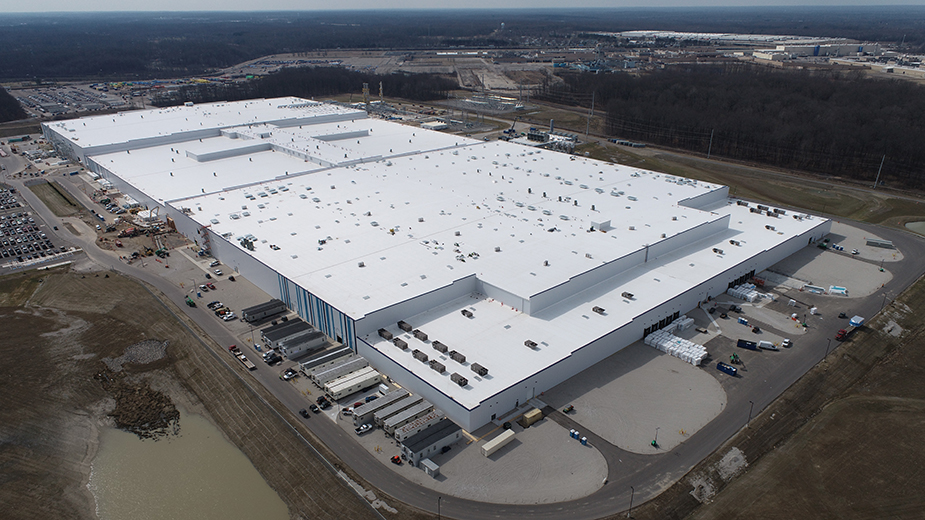LORDSTOWN, Ohio – Already, a $2.3 billion manufacturing plant that remains months away from shipping its first product is having a significant economic impact across the Mahoning Valley.
In the short-term, restaurants and hotels in the area and the building trades have enjoyed a jolt of activity from Ultium Cells LLC’s battery-cell production factory under construction in Lordstown.
For the long-term, the very presence of such a modern manufacturing complex dedicated to supplying the emerging electric-vehicle industry is likely to attract sustainable investments and thousands of jobs for years to come, specialists say.
Ultium – a joint venture between General Motors Co. and Korea-based LG Energy Solution – is installing production lines and processing equipment to fill its massive, 2.8 million-square-foot-plant. By this summer, commercial shipments of its first battery cells should begin, inaugurating an entirely new era in Mahoning Valley manufacturing.
“We’ll have the first two lines operating by the end of this summer,” says the plant director at Ultium, Kevin Kerr. These first battery cells will serve GM’s Factory Zero in Detroit, where the GMC Hummer EV is in production.
Also slated for Factory Zero is production of the 2024 Hummer EV SUV, the Chevrolet Silverado EV, and future models not yet announced. As demand increases and new EV models roll off GM’s assembly lines, the Lordstown plant will increase its production capacity. By the close of 2023, all of the manufacturing lines at the factory should be in place to supply GM’s existing EV portfolio.
Kerr says Ultium has hired approximately 250 people and expects to have hired 600 salaried and hourly employees by the end of this year. “We’ll add positions as we add volume,” he says. Although the company initially reported that the Lordstown plant would employ in excess of 1,100 workers by the end of 2023, Kerr places that number closer to 1,300.
Ultium is looking to fill positions such as production operators, quality inspectors, equipment maintenance personnel, engineers, and production supervisors, Kerr says. “Some technical support as well,” he says.
The Lordstown plant is the first of its kind. Ultium has since announced the construction of two other similarly sized plants, one in Spring Hill, Tennessee, the other in Lansing, Michigan. A site for a fourth plant has not been announced.
“Our cells will primarily go to support a lot of products at Factory Zero,” Kerr says. Production of the 2022 Hummer EV began in late 2021, he says, and that vehicle will use battery cells imported from LG in Korea until the Ultium Lordstown plant is in operation.
“Then, we ramp up and take over,” he says.
MANUFACTURING PROCESS
Ultium manufactures rectangular “pouch” battery cells that make up the heart of an EV. The first phase in the manufacturing process is the creation of chemical mixtures that combine raw materials such as lithium, carbon and nickel to produce electrode sheets for Ultium batteries.
The second phase of production is assembly, Kerr says.
“It’s a high-speed semiconductor assembly process where you’re forming the battery pouch,” he explains.

The electrode sheets are stacked with separators between each sheet of anodes – which produce a negative discharge – and cathodes, which emit a positive discharge, to form a bi-cell. These bi-cells are then laminated and cut to specific dimensions.
A third and final component to cell manufacturing is an aging process that lasts some 30 days. Then, the cell cycles through charge and discharge testing and is shipped to the customer, in this case, General Motors. GM will then manufacture the battery pack used in its new line of EV vehicles.
“What’s unique from the GM perspective is that we’ve come up with a cell that can be configured in a variety of ways,” Kerr says. “There’s a lot of flexibility. We can configure those cells to provide more power. And if you’re building something smaller, we can reconfigure those cells as well.”
BUILDING A SUPPLY CHAIN
Critical to the success of Ultium Cell’s Lordstown venture is a secure, reliable supply chain.
“A lot of our products do come from overseas,” Kerr says. “Right now, we’re looking across the whole value chain and assessing what elements of it can be localized in North America” to streamline logistics and realize a lower cost structure.
Some of this is in the works, Kerr says.
Li-Cycle Holdings Corp., based in Toronto, plans to construct a 120,000-square-foot recycling operation next to the Ultium plant. This, he says, could be a valuable asset to Ultium Lordstown, since Li-Cycle has the capability to extract rare earth elements such as cobalt, nickel and lithium from batteries at the end of their lives. These raw materials could be recycled to produce cathode and anode charges.
“They could potentially supply us or expand beyond that,” Kerr says. “A lot of it is under discussion.”
Today, China controls 82% of the global cathode production market and 100% of anode production. This opens up opportunities in the domestic supply chain – particularly in Ohio – to attract new investment in manufacturing cathode active materials, or CAM, according to a report (See page 11) that JobsOhio released in February, along with the Natural Resources Defense Council and Benchmark Mineral Intelligence.
The report, “Ohio Supply Chain Opportunities,” concluded that attracting CAM production to Ohio would provide the best opportunity to create jobs in an EV supply chain.
Central to attracting this investment is the Ultium plant, which will produce more than 30 gigawatt hours annually – enough to supply approximately 300,000 EVs.
Based on that output, the Ohio Supply Chain study found that an additional 1,735 jobs could be created in raw materials processing once the Ultium plant is in full production. More than one-third of those positions, or 615 jobs, would be created in CAM manufacturing, the report estimated.
Meanwhile, one supplier to the plant, I-Master Corp. of South Korea, is setting up shop on Meridian Road in Austintown.
I-Master, an industrial automation company, will be sending some “components into the plant for production, says Jim Grantz, commercial real estate agent for Edward J. Lewis Inc., who worked with the company to secure the space.
“Anytime you’re adding more than 1,000 manufacturing jobs, you’ll see an impact,” says Guy Coviello, president and CEO of the Youngstown/Warren Regional Chamber. “I know our team is working with domestic and international companies that want to be close.”
And the reason these companies are considering this region is Ultium. “The narrative is rapidly changing at the forefront of this new technology,” Coviello says.
Anchored by Ultium – plus the prospect of Foxconn’s purchase of Lordstown Motors Corp.’s plant and assets such as Brite Energy Innovators in Warren – the Mahoning Valley could collectively spur thousands of direct, indirect and induced jobs tied to the EV market.
An economic impact analysis developed by Brite and the Chamber shows that 1,700 direct jobs could be created between Ultium and Foxconn in Mahoning and Trumbull counties. These positions would constitute $502.1 million in labor income alone, the analysis estimates.
The EV hub would lead to another 3,478 indirect jobs, while the analysis projects 3,449 induced jobs – that is, jobs created by local spending from new direct or indirect hires.
In all, the presence of companies such as Ultium could eventually lead to the creation of 8,628 jobs in the region that boast a total income of $861.1 million, the analysis shows.
“We’re confident the Ultium plant is going to attract additional investment through the supply chain,” says Jim Kinnick, executive director of the Eastgate Regional Council of Governments.
Eastgate and other local development agencies such as the Western Reserve Port Authority and the Regional Chamber have based a new application for $25 million in federal funds to improve infrastructure across the Mahoning Valley on this anticipated growth.
The proposal, called a Live (an acronym for logistic innovation vehicle electrification) Zone, requests $25 million through the federal government’s Raise grant program.
An initial proposal was turned down two years ago, Kinnick says, but the latest application includes a much broader, regional approach relative to the impact of Ultium and the EV market.
“A $2.3 billion investment from GM enhances any opportunity to get additional investment when it comes to electrification,” he says.
IMPACT UNDERWAY
The ripple effect of the Ultium plant is gaining steam, as evidenced by thousands of tradesmen working on the construction phase of the project, the arrival of hundreds of engineers and managers from overseas who are supervising the installation and design of the plant.
Ultium’s Kerr says the huge construction project has averaged about 2,000 members of the building trades on site every day for almost a year. “That’s important,” he says.
As contractors put the finishing touches on the exterior of the building, other trades are busy installing equipment and preparing the interior work, he says.
“It’s been huge for us,” says Martin Loney, president of the Western Reserve Building and Construction Trades Council. “Without this project, I think we would have been really slow.”
Construction work at the plant should continue for another year or so, Loney says, as the plant ramps up production.
He says pipefitters and electricians have most likely received the most work at the site, noting that the Pipefitters union had to draw from 26 locals from across the country to staff the job.
“We had about 160 coming from different locals,” Loney says, who is also the business agent for Plumbers and Pipefitters Local 396 in Boardman. “For us, we had a total of just under 300 fitters. So it’s been great for our pension funds and health plans,” he says.
Elsewhere, managers associated with Korea-based LG Energy Solution have made themselves at home in the region.
In December, LG Solution Partner LLC, a company that maintains processing and production equipment for the Ultium project, purchased the Niles Professional Building for $120,000. The company is advertising for an equipment maintenance technician with a pay range of $53,000 to $69,000 annually, according to an online jobs posting.
The influx of Korean managers and engineers has also led to robust business activity in nearby communities such as Austintown. A new restaurant, Korea, recently opened to satisfy the tastes of many of the LG Energy Solution representatives and introduce a new cuisine to the Mahoning Valley. A second Korean restaurant is slated for Austintown.
Plant construction has also boosted the local hospitality industry.
“We have a couple of groups staying with us,” says Beth Sciarrone, director of sales at Home 2 Suites by Hilton, near the Interstate 80-state Route 46 interchange in the township. “They have a significant amount of rooms. If we could allow it, they could fill our whole hotel.”
Many of those from Korea who work in the Mahoning Valley have 30-to 90-day work visas. So these guests are often on a rotating schedule.
“There are hundreds of workers and they are a good group,” Sciarrone says. “I believe all of the hotels in the Austintown and Niles area are benefiting from this.”
Lordstown Mayor Arno Hill says tax revenues from just the construction phase of the Ultium plant could be significant. While unsure of what those numbers look like, he says that income tax derived from the construction of the $900 million Lordstown Energy Center brought in more than $500,000 in tax revenue.
“The ripple effect could be huge,” he says, noting that the Lordstown area commands significant interest from potential developers. “We’ve had some that do electrolyte production for batteries looking, a lot of interest in warehousing, but nothing definitive.”
“We’ve even had some inquiries about new hotels and motels along the Bailey Road area,” the mayor says.
Pictured: Ultium Cells’ $2.3 billion battery cell plant in Lordstown is being readied for production this summer.
